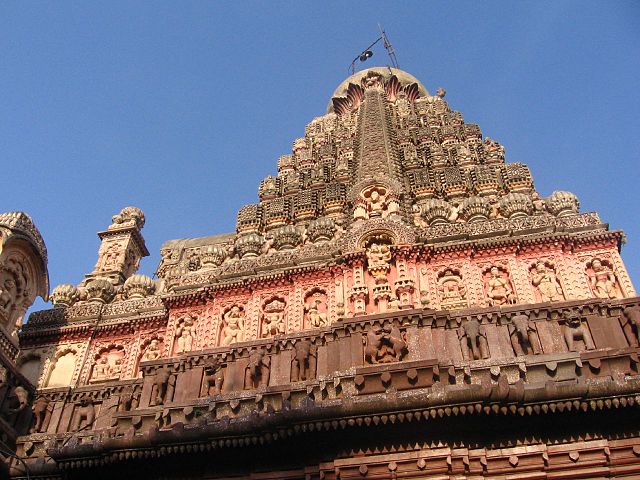
File:Grishneshwar Temple.jpg

| |
This is a file from the Wikimedia Commons. Information from its description page there is shown below.
Commons is a freely licensed media file repository. You can help. |
| Description | Grishneshwar Temple is an ancient pilgrimage site revered as the abode of one of the 12 Jyotirlinga manifestation of Lord Shiva. The Grishneshwar Jyotirlinga shrine is located at a village called Verul, which lies 20 km from Daulatabad (near Aurangabad in Maharashtra) and approximately 100 kms from Manmad station. Located close to Daulatabad (once known as Devagiri) is the popular tourist attractions Ajanta - Ellora. The Grishneswar Temple was constructed by Ahilyabhai Holkar who also re-constructed the Kashi Viswanatha Temple at Varanasi and the Vishnu Paada Temple at Gaya. The Grishneshwar Temple is also known by several other names like Kusumeswarar, Ghushmeswara, Grushmeswara and Grishneswara. Legend Behind Grishneshwar Temple According to Shivapuran, in the southern direction, on a mountain named Devagiri lived a Brahmin called Brahmavetta Sudharm along with his wife Sudeha. The couple did not have a child because of which Sudeha was sad. Sudeha prayed and tried all possible remedies but in vain. Frustrated of being childless, Sudeha got her sister Ghushma married to her husband. On the advice of her sister, Ghushma used to make 101 lingas, worship them and discharge them in the near by lake. With the blessings of Lord Shiva, Ghushma gave birth to a baby boy. Because of this, Ghushma became proud and Sudeha started feeling jealous towards her sister. Out of jealously, one night she killed Ghushma?s son and threw him in the lake where Ghushma used to discharge the lingas. Next morning, Ghushmas and Sudharm got involved in daily prayers and ablutions. Sudeha too, got up and started performing her daily choirs. Ghushma?s daughter-in-law, however, saw stains of blood on her husband?s bed and parts of the body drenched in blood. Horrified, she narrated everything to mother-in-law Ghushma who was absorbed in worshipping Shiva. Ghushma did not deter. Even her husband Sudharma did not move an inch. Even when Ghushma saw the bed drenched in blood she did not break down and said he who has given me this child shall protect him and started reciting ?Shiva-Shiva?. Later, when she went to discharge the Shivalingas after prayers she saw her son coming. Seeing her son Ghushma was neither happy nor sad. At that time Lord Shiv appeared before her and said - I am pleased with your devotion. Your sister had killed your son. Ghushma told Lord to forgive Sudeh and emancipate her. Pleased with her generosity, Lord Shiva asked her another boon. Ghushma said that if he was really happy with her devotion then he should reside here eternally for the benefit of the multitudes in form of a Jyotirling and may you be known by my name. On her request, Lord Shiva manifested himself in the form of a Jyotirling and assumed the name Ghushmeshwar and the lake was named as Shivalaya thereafter |
| Date | 26 April 2008, 07:42 |
| Source | Grishneshwar Temple in Daulatabad
|
| Author | sowrirajan s from Chennai, india |
Licensing
| This file is licensed under the Creative Commons Attribution 2.0 Generic license. | ||
http://creativecommons.org/licenses/by/2.0 CC-BY-2.0 Creative Commons Attribution 2.0 truetrue |
| This image, originally posted to Flickr, was reviewed on December 7, 2008 by the administrator or reviewer File Upload Bot (Magnus Manske), who confirmed that it was available on Flickr under the stated license on that date. |
File usage
Metadata
| Camera manufacturer | Canon |
|---|---|
| Camera model | Canon PowerShot A520 |
| Exposure time | 1/1,000 sec (0.001) |
| F-number | f/4.5 |
| Date and time of data generation | 07:42, 26 April 2008 |
| Lens focal length | 5.8125 mm |
| Orientation | Normal |
| Horizontal resolution | 180 dpi |
| Vertical resolution | 180 dpi |
| File change date and time | 07:42, 26 April 2008 |
| Y and C positioning | Centered |
| Exif version | 2.2 |
| Date and time of digitizing | 07:42, 26 April 2008 |
| Image compression mode | 5 |
| Shutter speed | 9.96875 |
| APEX aperture | 4.34375 |
| Exposure bias | 0 |
| Maximum land aperture | 2.75 APEX (f/2.59) |
| Metering mode | Pattern |
| Flash | Flash did not fire, compulsory flash suppression |
| Colour space | sRGB |
| Focal plane X resolution | 10,142.857142857 |
| Focal plane Y resolution | 10,142.857142857 |
| Focal plane resolution unit | inches |
| Sensing method | One-chip colour area sensor |
| Custom image processing | Normal process |
| Exposure mode | Auto exposure |
| White balance | Auto white balance |
| Digital zoom ratio | 1 |
| Scene capture type | Standard |
Want to know more?
SOS Childrens Villages aims to make Wikipedia suitable for young learners. SOS Childrens Villages is there for the children in our care until they are ready for independence. Have you thought about sponsoring a child?
